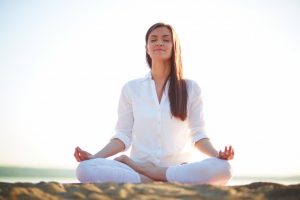 Types of Yoga
Types of Yoga
Yoga is not just an activity that relaxes or energizes; its effects go beyond just the physical, for it can bring inner contentment, feelings of happiness, insight and understanding of life, as well as other benefits.
There are many different yoga paths that lead to this state of harmony with oneself. The highest goal of a yogi is enlightenment (samadhi), in which he can know his inner self, thereby freeing himself from outside influences. One of these ways is raja yoga, the yoga of meditation. To be able to sit up straight, and concentrate in a meditation posture without moving requires some physical training, which is where hatha yoga comes in. Hatha yoga is a combination of physical poses (asanas) and breathing exercises (pranayama). Only with a healthy body and calm breathing can you manage the difficult task of meditation.
History
Yoga has been practiced for several thousand years in India. This is why the names of the exercises are all in Sanskrit, the oldest Indian language. The word “yoga” can be translated as “unity” or “harmony.”
One syllable in Sanskrit is “om” [symbol] (pronounced “Ohmm”). It is also called the spoken essence of the universe. It is often said at the beginning and end of the yoga session to bring the body and mind into harmony.
Yoga Master
Swami Sivananda (1887-1963) and Swami Vishnu Devananda (1927-1993), two famous Indian yoga masters put together a Hatha Yoga teaching series in line with ancient traditions, geared toward the needs of Westerners. Swami Vishnu Devananda was one of the yoga masters who brought yoga to the West (USA, Canada, Europe).
Hatha Yoga
“Ha” means “sun” and “tha” means “moon.” Yogis use these terms to designate two important energies that each one of us possesses. Lunar energy is feminine, emotional, intuitive, while solar energy is masculine, analytical, extroverted.
Elements of Hatha Yoga
The following are the cornerstones of yoga:
- Physical exercises (asanas)
- Breathing (pranayama)
- Relaxation (shavasana, yoga nidra)
- Positive thinking and meditation
The asanas have an effect that transcends the physical, and, particularly when poses are held for a long time and when breathing and concentration are coordinated with the poses, they influence the energy centers (chakras) and energy channels (nadis), similar to the meridians in traditional Chinese medicine (TCM). While the effects of functional gymnastics are often limited to the muscles and joints, yoga works much more on the organs and therefore the metabolism of the body as a whole. The exercises help to stimulate and harmonize physical processes.
Relaxation and meditation exercises prepare the body for the yoga session or accelerate the regeneration of energies after the session. They also calm the mind and harmonize energies, thus creating a holistic effect on the yoga practitioner (yogi).
Yoga Today
Both at work and at home, the pace of modern life requires us to be flexible, adaptable and dynamic, and it is constantly increasing. We are also becoming more and more specialized and sophisticated. We often neglect our own bodies in the process and only start to take notice of it if we get sick.
To stay sane in this crazy world, our desire to find a feeling of inner unity will become stronger and stronger, including the need for peace of mind and to allow the body to compensate for our sedentary lifestyles.
The held poses in yoga give us time to become aware of our own bodies. Yoga teaches us how to use our muscles effectively. By harmonizing breathing, muscle contraction and relaxing, the body is allowed to follow its own rhythm.
In the truest sense of the word, yoga offers space and time for personal development.
Please note – you should be careful of the following:
- Discuss your personal yoga program with a physician, physiotherapist or yoga teacher if you are due to have an operation in the near future or suffer from acute or chronic illnesses, from muscular wear and tear, wear a prosthesis, or have a limited range of movement.
- Avoid inverted postures if you suffer from raised blood pressure, colds or back injuries.
- If you have an acute slipped disk, avoid twisting movements or back bends.
- Pain is a warning signal that must be taken seriously.
Yoga can sometimes be difficult or require great flexibility, but it should never cause you pain.
- Talk with a yoga teacher or read the appropriate specialist literature if you are pregnant.
Tips:
◆ Never exercise immediately after eating.
◆ Wear comfortable clothing.
◆ Depending on the exercise you are doing, use a soft, warm or non-slip mat.
◆ Take your time. Avoid interruptions.
◆ Concentrate and be mindful as you exercise. Be aware of your body. Be aware of your breathing at all times. Practice with your eyes closed as often as possible, as this encourages inner awareness.
◆ Use aids (chair, cushion, etc.) if you are not yet capable of doing the basic exercises.
Yoga can help you …
Physically:
- Lower blood pressure
- Increase lung capacity
- Strengthen nerves
- Increase flexibility
- Eliminate tensions
- Relieve pain
- Improve immune defense
- Improve digestion
- Delay the signs of aging due to improved metabolism
Mentally:
- Improve concentration
- Develop greater awareness
- Become more responsible
- Develop greater flexibility
Spiritually:
- Patience
- Contentment
- Serenity
- Equilibrium
- Inner calm
- Self-confidence
Post Views: 149